|
<% ns_puts [mkm_getnavbar] %>
|

The Rosewall Underspin Backhand
Jim McLennan
Senior Editor, TennisONE
To see the animation of the Rosewall backhand, click here.
The one handed underspin backhand can be the most graceful stroke on the court. In
spite of all the two fisted strokes in the modern game, if you ever saw Ken Rosewall's
underspin backhand in his prime, you know that the stroke looked simple but was
devastating. Topspin, underspin, delicate chip returns, touch drop shots, anything is
possible from this classic stroke. The key is in the positioning of the wrist and elbow.
The following pictures illustrate the classic Rosewall underspin backhand.
.  
When played at the highest levels, tennis appears truly
simple. With apologies to the hustle and bustle of Courier, Rosewall (and today Sampras)
displayed the clean and uncomplicated style that we have come to know as
"classical." It all starts with the wrist in the natural position. In the first
photo above I am resting my forearm, wrist and hand on the racquet. It's neither locked,
flexed, clenched, or bent--let's just say it rests "naturally." In the second
photo, holding a subtle backhand grip my wrist is again in the natural position.
Important, there's no need to lock the wrist (check out Sampras if you don't believe me).
The third photo shows a common problem, bending the wrist to try and lock it. This looks
awkward and feels awkward--avoid it at all costs.
 Having set my
wrist with the backhand grip, now let's examine the elbow. In the photo to the left I am
pointing out that the elbow is naturally bent, not stiff as a board, not hyperflexed, just
comfortably bent. A checkpoint is to see whether your hand is away from the body and
in front of your breastbone--the classic position for the backhand slice swing.
Why so much on the bent elbow? Tennis players need feel, need the ability to adjust their
arm if the ball isn't exactly in the strike zone. They need to minimize effort and
maximize results. The elbow is the key. When bent I can easily adjust the hand and
racquet. When bent, I can adjust my hands up for a high contact, or down for a low
contact. When bent, it appears to be a "neutral" backswing, neither high nor
low. Having set my
wrist with the backhand grip, now let's examine the elbow. In the photo to the left I am
pointing out that the elbow is naturally bent, not stiff as a board, not hyperflexed, just
comfortably bent. A checkpoint is to see whether your hand is away from the body and
in front of your breastbone--the classic position for the backhand slice swing.
Why so much on the bent elbow? Tennis players need feel, need the ability to adjust their
arm if the ball isn't exactly in the strike zone. They need to minimize effort and
maximize results. The elbow is the key. When bent I can easily adjust the hand and
racquet. When bent, I can adjust my hands up for a high contact, or down for a low
contact. When bent, it appears to be a "neutral" backswing, neither high nor
low. 
I modeled my backhand underspin after the great
Rosewall, and I hope our backswings are somewhat similar (even if the results weren't). My
shoulders are well turned, the elbow is still relaxed, and I am looking over my shoulder
at the ball.
From here, I'll let Ken Rosewall take over.
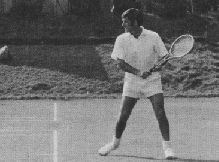 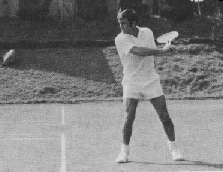
Note the distinctive position of Rosewall's racquet in the first photos (parallel to
the ground). It looks as if he is going to hit the ball with the edge of his racquet
rather than the strings.
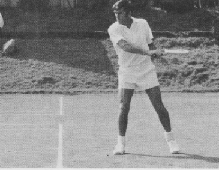
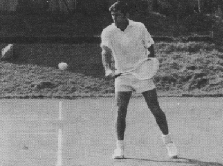
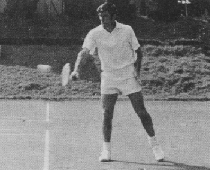 However, as Rosewall accelerates the racquet forward,
his forearm rotates to bring the racquet head completely perpendicular to the ground, thus
striking the ball with a vertical racquet face, which enabled Rosewall to hit his
underspin with power as well as control. While I disagree, some tennis experts
might say that this wrist and racquet rotation adds more complexity than the average
player can handle when learning this shot. However, as Rosewall accelerates the racquet forward,
his forearm rotates to bring the racquet head completely perpendicular to the ground, thus
striking the ball with a vertical racquet face, which enabled Rosewall to hit his
underspin with power as well as control. While I disagree, some tennis experts
might say that this wrist and racquet rotation adds more complexity than the average
player can handle when learning this shot.
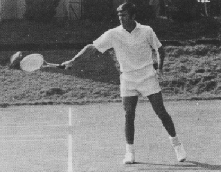 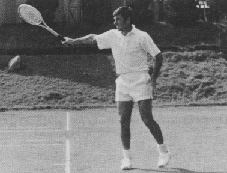
Note as Rosewall finishes his shot, his body remains sideways and his arm and racquet
head move up in a long, smooth follow-through. With Rosewall, there is no high-to-low
chopping motion you often see with underspin shots. The take-back and follow-through
follow a much more neutral plane, which allowed Rosewall to drive the ball his underspin
backhand. How effective was the Rosewall backhand? It played a large part in his 7
Grand Slam singles titles and 18 total Grand Slam titles. If you haven't developed an
effective underspin shot yet, maybe you should consider emulating the great Rosewall.
To see the animation of the Rosewall backhand, click here.
Go To: Tennis Lessons Library |